A 20th Century History and Status Report on Backgammon:
One Individual's Perspective
In an attempt to clarify the current status of the game of
backgammon I have written this article. The fact is that I am merely
an observer and have no special qualifications. Many people are
capable of writing this, yet I don't think any have. The info
here is accurate to the best of my ability. A few of my observations
are mere speculation. Hopefully I make those clear.
The game of backgammon in some form or another has existed for several millenia. The current "Western version", which I concentrate on here, has been played for only about 3/4 of a century. I emphasize Western because a related version is played in the Eastern Mediterranean and Eastern Europe. The major difference between the two games is the use of the doubling cube in the Western form. Surprisingly the inventor(s) of the cube remains unknown even though it has existed only since the 1920's. This one modification leads to such a rich enhancement of strategy and tactics that the modern Western backgammon has separated itself from its more fundamental relative. My comments from now on are only intended to relate to this form and I will now dispense with the "Western" adjective. ("Eastern" backgammon is also quite popular, and probably has many more proponents/players. A similar status report would be interesting to many GammOnLine readers.)
Part I: A Brief History of Backgammon—1920-1990
1920's ("Roaring 20's")
Backgammon experienced it's first Renaissance of the 20th century. Several books were published on the basics. The game appears to have been played primarily by the upper class in private clubs. Its decline likely was a result of the Stock Market Crash and the ensuing Great Depression.
1940's
With the appearance of a few more introductory texts, there was likely a small surge in popularity in this decade. Based on the contents of these books it appears that the quality of play was probably similar to the 1920's. World War II, the long recovery, and the housing and "baby" booms that followed kept much of the world othewise occupied for about 20 years.
1960's
Backgammon's initial late century climb in popularity is credited to Prince Alexis Obolensky. "Oby" promoted invitational tournaments, including the "World Championships" which started in 1964 and were held in the Bahamas. That first WC had 40 entrants and by the end of the decade a 128-bracket was being filled. Other large tournaments in the 60's were played in Las Vegas, London, and Estoril, Portugal. Oby also began the book writing trend in 1969 with Backgammon: The Action Game (MacMillan) coauthored by Ted James. The back cover is highlighted: "Learn the favorite game of the international pace-setters." The game was soon to leak out of the private clubs inhabited by the upper class.
1970's
This decade would prove to be the most prolific of the century for BG. All parts of the game—tournaments, literature, and publicity— thrived. Personally, I was introduced to the backgammon in 1975 through my involvement with bridge tournaments (ACBL). I don't know if it is simply my prejudice, but I believe the explosion of backgammon's popularity was helped significantly by its seeding in the tournament bridge community. Many of backgammon's early champions (for example, Oswald Jacoby, John Crawford, Tobias Stone, and Billy Eisenberg—simultaneous holder of the World Champion titles of both bridge and backgammon in 1976) were world class bridge players.
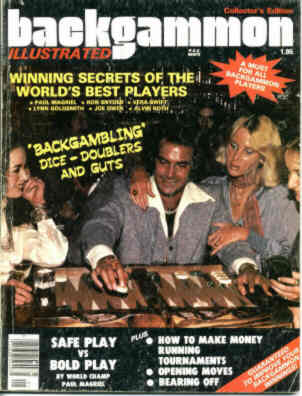
| Figure 1. Sex sells backgammon, too! Cover of a short-lived publication from 1976. |
By the second half of the decade, backgammon was extremely popular not only in the adult social and recreational establishments (country clubs, night clubs, etc.) but among young people as well. The game had expanded from the upper class to the booming middle class. A backgammon set was a typical Christmas gift. Local weekly tournaments were common in cities larger than 100,000 population and national tournaments thrived. In Indianapolis, where I lived, there were a series of Saturday afternoon round-robin contests held at different shopping malls. Even though the prize pool was minimal (these events were aimed at beginners) the attendance of each was around 100.
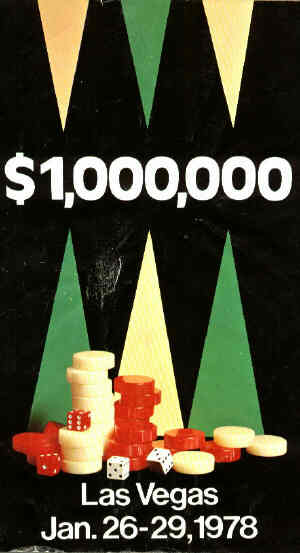
|
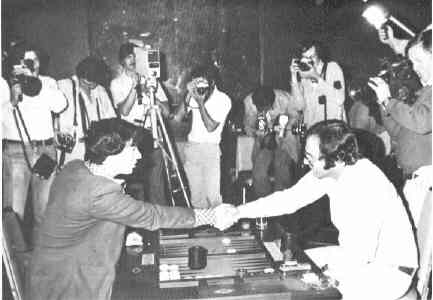
| |
| Figure 2. Ron Rubin (on the left) of New York congratulates Chico Felberbaum of Alberta, Canada at the conclusion of the finals of the 1st World Amateur Backgammon Championships. 1st paid $180,000 while Rubin earned $90,000. 702 players competed for $370,000 in prizes, not quite what the advertisement (seen on left) hyped. (From Backgammon Guide, Fall 1978.) | ||
The US national tournament scene was also going strong. Most major cities held regional (full weekend) tournaments with multiple divisions and significant entry fees and prize pools. The "World Amateur Backgammon Championships" with the "Plimpton Cup" trophy were promoted by Henry Wattson (of New York) and backers. Held in Las Vegas, these annual events flaunted six (originally advertised as seven!) figure purses. And even though prominent champions were not allowed entry, there was a simultaneous open event which attracted most of the big names, at least from the US.
Although much of this article concentrates on the US backgammon scene, Europe was also participating in the surge. Lewis Deyong (a top promoter and player) describes the flavor in his Playboy's Book of Backgammon (Playboy Press, 1977), a must read for its entertainment value alone. Big names (and personalities) from Europe included Joe Dwek and Kumar Motakhasses. The US had Paul Magriel, probably the most publicized pure backgammon player in history. (I qualify "pure" to distinguish him from celebrities like Omar Sharif and Lucile Ball.) Magriel was featured in articles of the top magazines, the most noteworthy story being in the June 4, 1979 issue of Sports Illustrated.
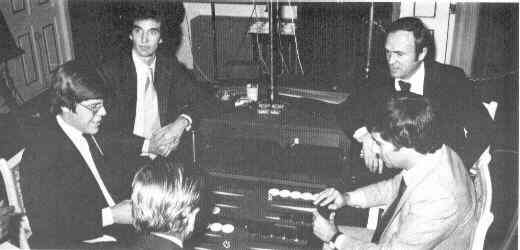
| ||
| Figure 3. Paul Magriel (left) plays Joe Dwek for $28,500 (winner-take-all) money style match held in Greece in 1977. Roger Low (left rear) was Magriel's consulting partner while Kumar Mothakasses (right rear) served in a similar capacity for Dwek. Magriel and Low won by the score 63-61. (From Backgammon Guide, Winter 1978.) | ||
New books appeared, with each year seeing the publication of a handful. Although initially merely beginning texts (like The Backgammon Book by Oswald Jacoby and John R. Crawford, The Viking Press, 1970), Magriel's 1976 publication of Backgammon (Quadrangle/New York Times Press) began a trend of truly challenging advanced texts. It is an accolade to Magriel's teaching ability that this now 23 year old work has never (in my opinion) been equalled by any book at either the beginning or intermediate level.
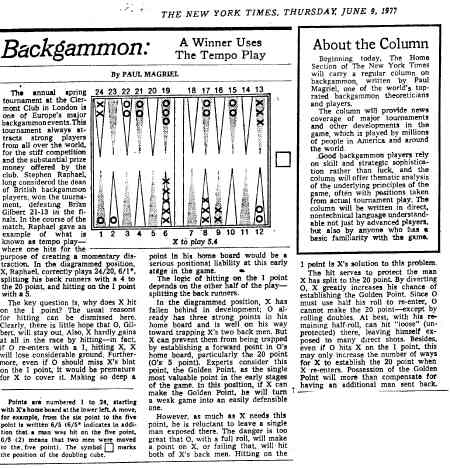
| Figure 4. First in a weekly series of backgammon columns by Paul Magriel. The column ran from 1977 to 1980. |
Organizations (like Les and Sue Boyd's International Backgammon Assoc.) surfaced. Their periodical Backgammon Guide was soon followed by others such as Las Vegas Backgammon Magazine and the slick but short lived Gammon. At the end of the decade, a newspaper format Backgammon Times came out. In 1977 The New York Times hired Magriel to write a weekly column which eventually produced on the order of 100 articles. Other large newspapers followed the trend. Local club newsletters became common, and some (like Chicago Point and Flint Area Backgammon News) survived to receive world-wide circulation. Backgammon was in its heyday.
1980's
Unfortunately, this decade may be best remembered as the one which saw a significant decline for backgammon. The game had become a fad, and suffered the demise associated with this label. I don't know what replaced backgammon (hopefully it wasn't Pac Man!) but the typical attrition of players was not replenished with new blood. The hard-core tournament players remained but the recreational types disappeared, and with them, so did the publicity. Fortunately, high quality literature hadn't reached its peak, and more classic works appeared by authors such as Danny Kleinman and Bill Robertie. Kent Goulding's 12 issue series Backgammon with the Champions borrowed an idea from chess—study the actual games of the top players. Backgammon intellectualism waxed as its popularity waned. Tournament attendance dropped and eventually only the stoutest tournament directors continued to hold big events.
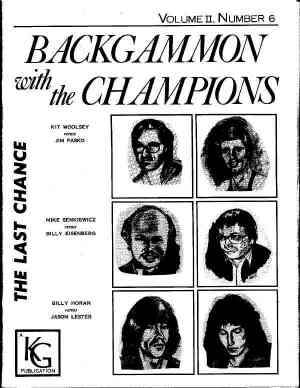
| Figure 5. Cover of the 12th and final issue of Kent Goulding's Backgammon with the Champions series. The publication was produced in 1981-83. Recognize anyone? |
Part II: The Computer Revolution
I don't know what the first computer backgammon game was. However, it is acknowledged that the first decent piece of backgammon software was the work of Hans Berliner, a computer science professor from Carnegie-Mellon Unviversity. Ironically, this very program was available for play on the Arpanet (the early forerunner of the Internet). We will see that this one-two punch—formidable backgammon computer players ("robots") and large area computer networking—would give rise to the third backgammon Renaissance of the 20th Century.Berliner's game surfaced in the mid-70's, I believe. Around 1977 a young Indianapolis entrepeneur and computer software specialist, Kim Brand, envisioned cashing in on the backgammon craze. His ideas was to design, build, and market a stand-alone backgammon set comprised of an attractive walnut and glass case with checkers being replaced with lights under to surface. The key to this product would be a world-class computer opponent.
Brand's vision was backed by conviction and capital. He hired both Berliner and Magriel to develop the software. Publicity culminated in 1979 when Brand took a prototype to Monte Carlo and put up $10,000 in a winner-take-all seven point match between "Aristotle" and the newly crowned World Champion who turned out to be Italian Luigi Villa. Dice were hand rolled (Motakhasses tossing for the robot). Magriel narrated the match which surprisingly was won by the computer, much to the relief of its fledgling, financially strapped developer! The results were reported internationally by the press. Unfortunately, few of the $2000+ sets were ever built and the project fell by the wayside. The software remained for a time on the Arpanet but today it is unavailable and possibly lost forever.
In the late 80's, a second breakthrough in software surfaced. Expert Backgammon (initiated by Tom Johnson and enhanced significantly by Tom Weaver of Dallas) became the first truly commercial backgammon robot which played at a competitive level. Although its quality of play was sub-world- class (as was the previously mentioned Aristotle), its true value was the ability to perform rollouts—repeated trials of a given position with random dice.
Rollouts were not new, but they had previously been performed by humans with hand rolled dice and standard backgammon boards. A long human executed rollout would be about 100 trials—not sufficient for statistical significance in most cases. Expert Backgammon could run thousands of rollouts overnight. For the first time, questions like "what is the best way to play an opening 62?" had the hope of being answered with scientific accuracy. Any owner of a personal computer (which had become commonplace by the end of the 80's) could shell out $100-$200 and have not only a decent opponent available 24 hours a day, but a tool capable of helping answer age-old questions in tactics. The computer revolution had hit backgammon in a big way.
The next major breakthrough, possibly the biggest in the history of backgammon, occurred around 1990. Gerald Tesauro, a computer scientist at IBM's Watson Research Center in New York, wrote a piece of software which actually taught itself backgammon by a neural networking technique known as Temporal Difference learning. The resulting software was coined TD-Gammon. (Although frequently misunderstood, I believe that TD-Gammon did have some human coaching along the way. In theory it apparently could have learned the game by simply starting with the rules.) IBM's interest was the development of this revolutionary learning method— a subclass of Artificial Intelligence—but a spinoff benefactor of this effort was the game of backgammon. Tesauro had created a legitimate world-class robot! Unfortunately TD-Gammon never went commercial, although a play-only version was included free of charge for IBM's OS-2 WARP operating system.
Coincident with the software development was computer networking. About 1993, Andreas Schneider of London started the First International Backgammon Server (FIBS) which was set up on an academic computer in Sweden. This service was provided free of charge to anyone with a (now booming) internet connection. There quickly grew a truly world-wide backgammon club open around the clock! Typically over 100 players were active at any time of the day. A ratings system (patterned after chess) was included on the server and players could not only rank themselves amongst the other members but could also track their own progress. Matches could easily be recorded for later self-study. Any member could watch live matches between world-class players. One can only imagine what Oby would have felt had he lived to witness this readily accessible spectacle!
What Tesauro had begun, others soon followed. Fredrik Dahl of Norway created Jellyfish, another world-class neural network. And he made his work commercially available. The neural net technique is so powerful that not only can it choose the "better" play (as Expert Backgammon could do), but it actually assigned values (in commonly used backgammon units—equity) to any arbitrary position. As strong as Jellyfish's evaluations were, even more reliable were its rollouts. Surprising to some, many of Jellyfish's rollouts confirmed previous rollout results performed by the limited brain of Expert Backgammon. But as a player, Jellyfish was encroaching upon the hallowed territory previously only occupied by the best humans.
The robots and the internet again combined—almost 20 years after Berliner's Arpanet software. Many strong robot opponents were created "in garages" and made available for all to play on FIBS. The previously mentioned TD-Gammon and Jellyfish were joined by other world class opponents like Loner and SnowWhite (or Snowie, to be described below).
Jellyfish continues to be a valuable tool and world-class opponent. Commercial competition arrived in 1998 with Snowie (created by Olivier Egger of Switzerland), another neural net trained robot. In its most advanced version, Snowie can perform full cube rollouts. Another valuable feature of Snowie is its ability to import and analyze entire matches with little operator intervention. The tools for human improvement continue to grow.
Part III: Present and Future
Other backgammon advances of the 90's included a journal quality publication—Inside Backgammon (which has sadly been discontinued). The internet accessible usenet newsgroup (forum) rec.games.backgammon receives about 20 posts per day. This free-form conversation-like facility specializes in giving everyone his/her say on conventional and unconventional ideas alike. Many excellent World Wide Web sites have been set up simply for the purpose of expanding the scope and knowledge of backgammon. Competition to FIBS (like the currently popular GamesGrid by CyberArts) abounds. Hardcopy books continue to be published. The first online backgammon magazine which you are currently reading is another testimonial to backgammon's continuing popularity.
Backgammon, for the moment, seems to have reached a sort of "steady state". Attendance in large US tournaments, which had again surged in the early and mid-90's, has leveled off. Membership on the servers appears to be reasonably constant as well. It is probably time for some new ideas to sustain the game's popularity, but it is not obvious to me if, where from, or when that will come.
What will the next decade bring? For now the surge in software capabilities seems to have reached a plateau. There has not been a true breakthrough on any dimension (intellectual or commercial) for a few years. Hopefully the current products will continue to improve but recent upgrades seem to be more on the cosmetic side (which is certainly welcome) than on an intellectual level. On the other hand, breakthroughs by their nature are not usually foreseen. And there is always that nagging question: is the game of backgammon nearly solved?
In retrospect, the quality of play has been steadily advancing over the past 35 years since Obolensky re-introduced to game to the public. Initially this improvement was available to a select few who were fortunate enough to live in the cities (like New York) where the innovative minds congregated. The strong texts helped, but the computer revolution has had the biggest impact in providing the masses (specifically those motivated to commit the time) access to the world-class level. For example, an isolated midwest farmer with some effort can, within a couple years, reach the level of the top champions of the 60's and 70's. Of course getting to the level of the current world class players is still a major challenge, but much easier than a similar rise would have taken back in the 70's.
A final unanswered (but answerable, in theory) question is "who is the best backgammon player today?" Some include in the best robots among the candidates. At money play, Jellyfish provided a serious challenge back in 1996 when it broke even in two long (but independent) money sessions against two of the World's top human players: Mike Senkiewicz and Nick Ballard. The jury is still out as to whether Jellyfish (or Snowie) is equal to or better than the best humans at money play.
At match play, the robots are probably a little more vulnerable. Although their choices in plays are completely determined by their neural net brains, their cube decisions are a combination of the neural net evaluation function and a human installed algorithm on the binary decisions: double/no double and drop/take. This human intervention aspect is even more fragile in match play. It's possible that a top level human player is superior in match play cube handling, but the difference is small enough that other actions (play decisions and positional cube evaluation) could still leave the robots as favorites.
One thing where humans have an advantage over the current crop of robots is in adjusting their play level to the particular opponent. Snowie and Jellyfish apply no active learning in their commercial versions. They always play the same game. Also, would psychological ploys by the robots help?
For all their perceived shortcomings, the robots still play at the level of the best humans. The question "who is the best backgammon player in the world" remains unanswered, but the robots are certainly on the short-list. 1984 seems like a distant memory but we still are living in a "Brave New World".